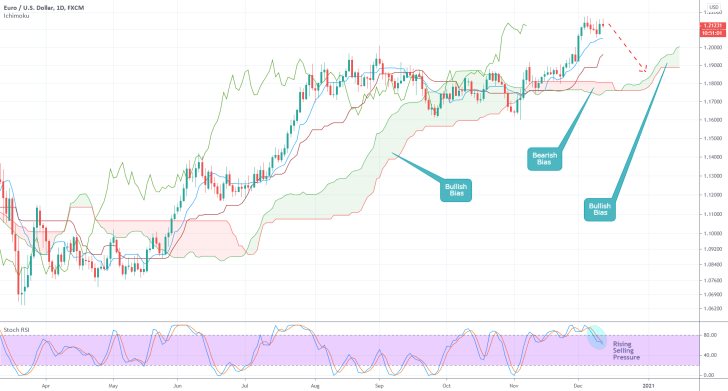
In a landmark deal that was reached yesterday, European leaders finally clinched a deal for a budget and recovery fund worth 1.8 trillion euros. The stalemate in the European parliament was finally broken after Germany negotiated an agreement that suited Poland and Hungary.
The two countries were resisting the proposal until yesterday due to fears that the EU could stop their funding on the grounds of them not upholding the rule of law. There is a rift of opinions in Warsaw and Budapest contrasting to other European countries; namely, relating to issues such as an independent judiciary and preserving the democratic principles.
Despite this unravelled gap of socio-political opinions in the heart of the bloc, which could pose a significant threat for the union's stability in the future, the stricken accord represents a major stepping stone for the European economies in their bid to recuperate from the coronavirus crash.
Deal on the #MFF and Recovery Package #NGEU
— Charles Michel (@eucopresident) December 10, 2020
Now we can start with the implementation and build back our economies.
Our landmark recovery package will drive forward our green & digital transitions. #EUCO
The news came shortly after the ECB decided to make its underlying monetary policy stance even more accommodative by boosting the envelope of its Pandemic Emergency Purchasing Programme (PEPP) with an additional 500 billion euros.
Thereby, the matching monetary and fiscal policies of the ECB and the European Parliament are bound to play a significant part for the post-pandemic recovery of the European economies. Meanwhile, another point of contention for the European integrity continues to be the stalemate in the Brexit negotiations.
At any rate, the news comes at a particularly 'happy' time for the Euro. As can be seen on the daily chart below, the EURUSD currently finds itself at the top of a massive uptrend.
Nevertheless, there is mounting evidence suggesting that the pair might be due to establishing at least a minor bearish correction; potentially sliding to the nearest Ichimoku cloud. Such expectations are substantiated by the Stochastic RSI indicator, which demonstrates rising selling pressure.

Trendsharks Premium
Gold is undergoing a correction, as investors take profits to offset losses from falling stock prices, impacting their margins. However, we anticipate a renewed wave of [...]
The Swiss stock market index is mirroring its global counterparts, such as Germany 40 and US100, experiencing a sharp decline following the announcement of new [...]
We’re analyzing the weekly chart to grasp the broader market trend. Over the past three years, the US30 index has surged by 17,000 points, often resembling a nearly straight [...]
Over the past week, the DAX has experienced a sharp decline, plunging by an astonishing 3,400 points. This downward movement is not isolated, as its international counterparts, such as the UK100 and US100, are also facing significant [...]
EURUSD recently formed a double top at 1.0930, signaling a potential trend reversal, and has since begun a correction. After a 600-pip rally since early March, a pullback at this stage is both expected and healthy. Given these conditions, we are placing a [...]
Since early March, EURJPY has surged nearly 1,000 pips, providing us with several excellent trading opportunities. However, as the rally matures, many early buyers are beginning to take profits, leading to a noticeable slowdown in the uptrend. On Friday, the pair formed a [...]
The AUDJPY currency pair continues to be dominated by bullish momentum, as multiple golden cross patterns reaffirm the strength of the ongoing uptrend. Despite this, we are witnessing a much-needed [...]
The EURAUD currency pair appears to be undergoing a trend reversal, signaling a potential shift in market direction. A notable technical development is the formation of a Death Cross on the chart, a widely recognized bearish indicator that typically suggests a [...]
After securing an impressive 200-pip profit last week, the EURJPY currency pair is now undergoing a southward correction, retracing some of its recent gains. Despite this temporary pullback, the Golden Cross remains intact, reinforcing our view that the overall trend continues to be [...]
The appearance of a Golden Cross in Silver strengthens our analysis that the metal is currently in a strong uptrend, indicating further bullish momentum in the market. This technical pattern, where the short-term moving average crosses above the [...]
This trade presents a considerable level of risk and can be classified as an opportunistic move based on recent price action. The GBPUSD currency pair has experienced a substantial bullish rally, surging by nearly 500 pips in a strong upward movement. However, after this extended period of appreciation, the pair is showing signs of a potential [...]
The anticipated Death Cross on the SMI20 appears to be failing as price finds strong support at the 23% Fibonacci retracement level. After testing this area, the index has shown bullish strength, printing several large green candles, signaling an increase in [...]
A Golden Cross has just appeared on the USDJPY chart, signaling a potential bullish move. This technical pattern occurs when the 20 period moving average crosses above the 60 period moving average, a widely recognized indication of increasing [...]
After 2 months of a down trend, we finally see some indications of price recovery for Oil. The golden cross, a historic buy signal, supports this [...]
For the past month, the German DAX40 has experienced a remarkable 10% surge, reflecting strong bullish momentum. Despite ongoing market volatility and frequent pullbacks, every dip continues to attract fresh buyers, reinforcing the [...]
Oil continues its downward trajectory, despite occasional pullbacks. The overall trend remains bearish, reinforced by multiple Death Cross patterns, a classic sell signal indicating further weakness. Adding to this bearish outlook, the critical [...]
Over the past few days, gold has experienced a sharp decline of more than $100. This downturn can be attributed in part to traders securing profits to manage their margins, which are under strain due to the significant drop in major indices. Currently, gold has fallen below the [...]
The NASDAQ 100 index is showing strong bullish momentum, as evidenced by the formation of a Golden Cross on the chart. This classic buy signal occurs when the short moving average crosses above the long term moving average, suggesting that upward momentum is [...]
The EURAUD currency pair has encountered a significant resistance level, failing to break above the critical 61% Fibonacci retracement level. This suggests that bullish momentum is weakening, reinforcing the case for a potential downward move. Given this technical setup, we favor entering a [...]
The UK100 is experiencing a remarkable rally! Over the past few weeks, the British stock market index has surged nearly 800 points. Each minor dip has attracted more buyers, fueling the bullish momentum. However, since last week, we’ve observed a slight [...]




















